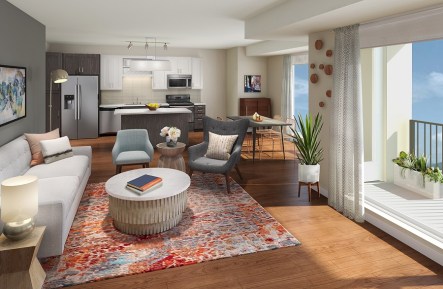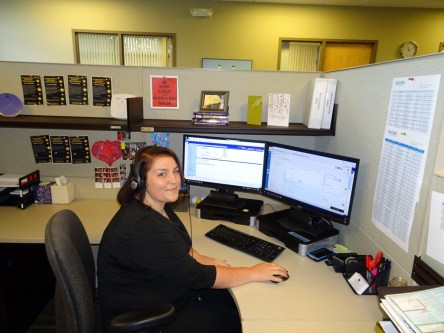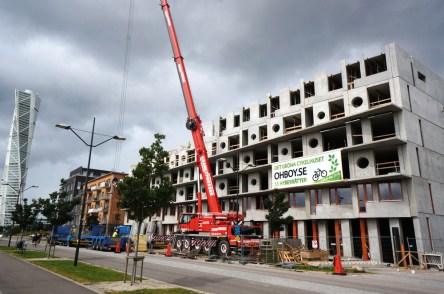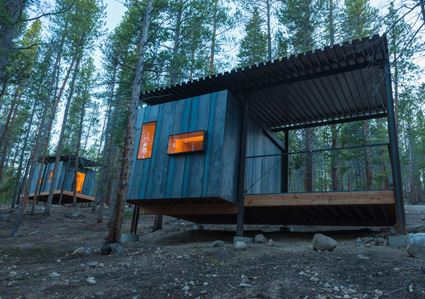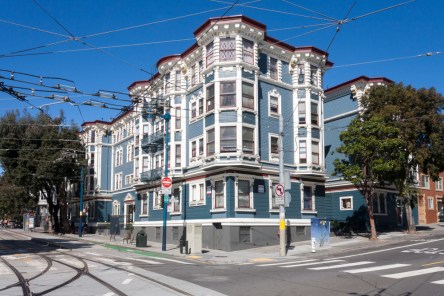Yardi Matrix reports another strong summer for the multifamily real estate sector. The fundamentals were downgraded from “great” to “consistently good” but several factors suggest continued, healthy performance. Even rapid development in some of the nation’s hottest markets has slowed to a more sustainable pace due to construction labor shortages. The shortages may have longer-lasting effects due to disaster recovery efforts throughout the United States. Rents For the last year-and-a-half, rent growth as gently declined as rents inched upward. The rent growth deceleration may be drawing to an end, though, as the supply boom reaches it apex. National average rents increased by 2.4% on a year-over-year basis in August, yet are down from 4.6% at this time last year. Deliveries are not manifesting as quickly as previously anticipated, which should moderate rent increases. The long-term outlook for multifamily seems promising due to favorable fundamentals and demographic trends: Millennials are forming households, wage growth remains solid, and the economy is relatively healthy. Hottest Markets The hottest metros for rent growth are still secondary markets that are lagging on supply. Tacoma (8.1 percent), Sacramento (7.7 percent), Colorado Springs (7.6 percent) and the Inland Empire (4.3 percent) are four of the fastest growing markets yet they’re only estimated to increase stock by 1 percent this year. These markets benefit from their proximity to larger markets such as Seattle, the Bay Area, Denver and Southern California. They enjoy vigorous employment growth and popularity with Millennials. The young renters look forward to the areas’ desirable lifestyles with lower costs. There are always exceptions. Seattle faced 5.9 percent rent growth regardless of the surge in supply. Analysts are exploring the connection between rents and the city’s increased minimum wage. Minimum wage increased from $9.47 in 2015 to $13. Nashville is...
Apartment Trends
RENTCAFE Construction Report
We’d need 4.6 million new apartments by 2030 to meet demand for rental living and keep prices in check, reports the National Multifamily Housing Council. That’s about 373K new units each year on average, a number that’s rather optimistic considering the pace of apartment construction in the last decade. So how feasible is this plan? A recent study from RentCafe on the apartment market suggests the country’s growing renter population need not be too concerned. According to data from real estate data provider Yardi Matrix, apartment construction is at a 20-year high, with most of our country’s biggest cities seeing significant upgrades in rental stock. After a slow post-recession period, the market started rebounding in 2012 and by 2014 new supply had amounted to more than 237,000 units delivered in one year, well above historical averages. Between 1997 and 2006, annual completions averaged 212,740 units. In 2017, apartment completions are expected to top 345,000, a 21% increase compared to last year’s deliveries when more than 285,000 units saw the light of day. Hot Urban Markets See Rents Softening as Developers Ramp Up Apartment Construction After peaking in 2014 at 5.1%, monthly rent prices rose just 1.5% to $1,316 in May, the lowest annual growth rate we’ve seen in more than three years. In 2017, the average U.S. rent is expected to increase a modest 3.9%. Does this mean apartment prices are finally taking a break from rent growth? Apparently so, and thanks to intensified apartment construction, that’s even the case with some of the country’s historically tight (or rather outrageously expensive) markets. Close to 6,200 new units entered the San Francisco metro area in 2016, with approx. 5,400 apartments expected to be delivered this year and another 9,500 under construction. While demand is still strong...
Smart Growth
Dominium Uses Yardi eLearning
New hire onboarding is a necessary process for all growing multifamily organizations. It is also a major pain point. Dominium, a Minneapolis-based leading apartment development and management company, set goals to double in size by 2025. To reach its goals, the company needs an innovative and efficient training solution. Maya Kasangaki, Senior Service Desk Technician and Yardi Trainer, explains how Yardi eLearning has prepared her organization for growth. Onboarding Dilemmas Dominium faced challenges that are familiar to other property management firms: high turnover and costly, inefficient training processes. The organization hosted monthly weeklong trainings for new community managers at the corporate office. In addition to regular conference calls, these nearly six-hour training sessions consumed the majority of Kasangaki’s time. Once complete, she lacked a consistent way to track students’ understanding and content retention. “If we have training with 12 people on the call, it’s hard to make sure that everyone is absorbing the information. They aren’t as comfortable bringing up questions or starting a discussion in the midst of a training,” she observes. High turnover exacerbated the already frustrating situation. “Because of the staff turnover in property management, we would train someone but they didn’t have basic knowledge of the industry. The information we provided was maybe going over their head. Then we would hire someone to replace them and we would have to begin this process all over again,” says Kasangaki. Dominium sought a training solution that would simplify and expedite new hire onboarding. Online Solutions for Onboarding and Growth In 2016, Dominium implemented Yardi eLearning. The company customized the curricula to include soft skills courses, videos, webinars, and more. Kasangaki appreciates the ability to deliver content in different formats, allowing learners to receive the information in a way that appeals to their...
Optimizing Data
Maximizing Revenue Part 2
Yesterday, we laid the foundations of a strong online presence. We now continue with how to gather insights from analytics to inform marketing and retention decisions. Micro-Adjustments Lead to Success When vacancy rates inch upward, resist the urge to slash prices. “Price should be the last negotiable item, not the first,” advises Sawh. Examine your SEM data, which will show leads generated and which keywords drive conversions. Use that information to adjust pay-per-click ads, the easiest marketing factor to manipulate. In a case study, Bell needed to fill several 2-bedroom units. Data revealed that people who visited the website’s Pets page were most likely to reach goal completion. The team marketed 2-bedroom units to pet lovers to successfully fill the units. You can also make adjustments based on prospects’ objections to visits and objections to leasing. Leverage Soft Data “Business intelligence tools can give you a purview in but it doesn’t tell you the story. Customer insight is the soft data, the human touch,” says Weaver. SEO and SEM generate traffic but once traffic is translated into website and site visits, ORM and customer relationship management (CRM) capture data about visitors. Both give insights into why visitors chose to lease (or not) with your property. Use data gleaned from ORM to tweak the resident and prospect experience. If several reviews indicate that the marketing doesn’t match the product, for example, it’s time to update your gallery and re-examine your marketing message. With prospects, poor follow-through lets many conversions slip away. “It will take eight times of someone telling you no before they say yes,” explains Norbury. “Three points of contact aren’t enough.” “What we tend to forget is that we paid, maybe $20, for the phone to ring. If we don’t answer or don’t...
Fair Housing
Updates from NAA
This week’s NAA Education Conference & Exposition kicked off with a special session on Fair Housing, The New Five: Fair Housing Issues You Didn’t Know About. Panelists Doug Chasick, President, The Fair Housing Institute; Theresa Kitay, Attorney, Law Firm of Theresa L. Kitay; and Kathelene Williams, Partner, Williams & Edelstein, P.C. led the discussion. The team compiled a list of five hot topics in Fair Housing that can be confusing due to recent changes and ambiguities. The forum discussed best practices to help housing professionals avoid liability. Chasick opened with a piece of general advice before diving in: let common sense comes to the rescue when gray areas arise. “Take off your Fair Housing hat and put on your ‘Do I want to be the next slide in their presentation’ hat,” he laughs. “We can’t forget the, ‘Be a decent person’ hat,” adds Kitay. Below are the panelists’ recommended best practices: Occupancy Policies – Many properties rely on a two occupants per bedroom standard. The panel suggests reconsidering that standard, as it can lead to disparate impact claims from families with children. Consider two people per bedroom, plus one per unit as a base. Additional considerations might include items listed in the Keaton Memo, special circumstances such as the age of kids (e.g. exclude infants from occupancy rules), the size of rooms, and extra finished rooms like libraries or lofts that can safely serve as a sleeping quarters. When it comes to evictions or rejecting an application based on past troubles, victims of domestic violence may also require additional occupancy consideration. See statement HUD 16-159, issued Oct 24, 2016 for additional details. Immigration Status vs. National Origin – Immigration status is not a protected category in Fair Housing in most states. National origin, however,...
Insights From AIM
3 Key Takeaways
Multifamily marketers from across the country converged in Huntington Beach for the 2017 Apartment Internet Marketing (AIM) Conference on May 7-10. Several hundred professionals gathered to explore the industry’s latest marketing trends and best practices. Here are three ideas from this year’s event that might buoy your marketing efforts: Tell Your Story Marketing is not just an exercise in generating the lowest cost per lead. It’s a complex combination of creativity and strategy that ultimately tells a story to potential customers. In a world of constant digital distraction, today’s marketers need to have the skills to create content that will rise above the noise. When it comes to creating engaging content, authentic storytelling and video rule. AIM panelists Jamie Matusek, President of Catalyst, Lori Valenti Webb, Director of Marketing at Wood Residential Services, and Anna Geary, Founder of Show My Property TV, explored the ideal customer experience. Matusek explained that experiences progress through the Happiness Halo framework, from anticipation to interaction to afterglow. Anticipation is the process of building excitement, teasing potential customers into wanting to know more. This can be seen in pre-event promotion and behind-the-scenes videos. Interaction immerses customers in an experience, providing emotional direction to aid in decision making. Multifamily application could be a time-constrained promotion, such as a rent discount, or highlighting property perks, such as free recreation classes or dog-friendly happy hours. Afterglow focuses on creating a positive memory, reinforcing brand positivity. As Matusek explained, bad things will happen, such as a poorly executed maintenance request or a negative front office visit, so it’s important to positively direct the sentiments with each resident touch point. Crafting an effective story can combine these three concepts into any medium, from a blog or social media post to a video. At AIM, video was...
9 Responsiveness Tips...
Communication Best Practices
Want to get in touch with your residents? SatisFacts 2017 Online Renter study reveals that 88 percent of respondents prefer to be contacted via email; 73 percent ask to be contacted by cell phone, and 50 percent request text communication. Each method of communication has its own best practices. Dive into these nine tips for effective responsiveness. EMAIL Email is old news but effective email techniques constantly change. You must find a way to make your emails stand out in inboxes that are flooded with spam and competitors. These tips may keep your emails from the trash folder: 1. HubSpot reports that 33 percent of email recipients decide whether or not to open an email based on the subject alone. Subject lines matter! Since 40 percent of emails are read via mobile device, keep your subject 30-50 characters max. Make the subject interactive by leading with a verb. “Party with us tomorrow night!” is more enticing than, “There is a party tomorrow night!” If you have an incentive, notify the reader in the subject line, such as “Get 10% off rent next month.” Add emojis at your own risk. Research tells us that readers dread all caps and excessive punctuation. More than 85 percent of respondents prefer an all-lowercase subject line to one in all caps. But emojis are a relatively new terrain. When used sparingly, they can make a good headline stand out. Downside: they might not translate well across devices and carriers. Also, certain demographics (and not others) appreciate emoji use. Lastly, integrate numbers when you can. Numbers stand out among text and they provide context. “2 weeks until your lease renewal” will have a higher click-through rate than “renew your lease soon.” 2. Timing matters. Consider the subject of your email...
Snap Happy
Property Marketing Goes Guerrilla
OMG’s, LOLZ’s, puppy-dog faces and flower crowns. Snapchat is sometimes reduced to these simple stereotypes and thought of as something to entertain the kids when the adults get tired of the noise at family dinners. But noise and chaos are staples of modern life, for company and consumer alike. And as the godfather of guerilla tactics, Sun Tzu, expounded upon millennia ago, “In the midst of chaos, there is also opportunity.” When fully leveraged, Snapchat can be used to cut through the chaotic noise, both at family gatherings and in today’s rental marketplaces, to turn potential opportunity into new prospects. Background All social media platforms once represented an unconventional and unrealized marketing space. This is no longer the case. Snapchat is one of the many recent social frontiers that qualifies as a guerilla marketing opportunity for brands. It’s a place where you can outmaneuver your competition through unconventional and creative means (without a huge budget), thereby gaining greater exposure and winning. Some continue to dismiss Snapchat as “just an app.” At one point, the doubters may have been correct, but as the scope of Snapchat’s business has expanded so has their reach. It’s now a social media platform that competes closely with the companies typically identified as giants in the space. Case Study So you want proof, eh? The intrepid property managers at Continental Realty Corporation (CRC) just so happen to be early Snapchat adopters, and they were kind enough to share the data of some recent campaigns with us. In October 2016, CRC ran two Snapchat filter campaigns for onsite events, one in the commercial space and one in the residential space. At the commercial property, CRC ran a custom filter for the “Jerry Adams Chili Cookoff.” The Snapchat filter campaign lasted for...
Targeted Marketing
Means quality leads
If your digital marketing campaigns simply generate leads, they are underperforming. Create campaigns that attract the highest quality leads and provide insights into tenant habits with a single business intelligence tool. Yardi Orion® Business Intelligence (BI) is a mobile-ready platform with more than 200 built-in key performance indicators. The software offers flexible reports and dashboards. The data gathered by Orion BI provides insightful, configurable reports that can be used by multiple tiers of leadership. Marketers can use Orion BI to identify lead sources for the highest quality renters: demographics that can reduce occupancy, minimize delinquencies, and promote lease renewals in one swoop. Orion BI highlights the cost per lease, showing users how many marketing dollars went into each conversion. Of the leases signed, renter behavior is then tracked. The data reveals which marketing sources attracted the most renters who paid their rent on time and which renters renewed their leases. Let’s say that your property ran ads on RentCafe.com, Apartments.com, and Forrent.com for one year. You wanted to know which of those sites resulted in the lowest cost per lease and the highest renewal rate. You could configure the parameters of your report to show those data sets. Upon discovering that RentCafe.com offered the highest quality renters, your marketing team would concentrate its resources towards that site. Your organization nixed marketing dollars on lead sources that underperformed. Orion BI can even help to fill specific types of vacancies. If your property has issues filling its studio units, you can create a report that shows which lead sources attracted renters who signed studio leases. You can also avoid lead sources where most renters seek out larger spaces. For more information on how Orion BI informs marketing decisions, join a...
Marketing to Boomers
Tips for Multifamily Firms
Did you know that Baby Boomers are the second largest demographic in multifamily housing? Most companies only spend five percent of their advertising budget (and even less effort) on this growing group. Don’t be like them. We’ve got eight tips to master online marketing to Baby Boomers. State your cost—clearly—and why your property is worth it. This fundamental tip is especially relevant to Boomers. They have a lot of money to invest in companies that meet their needs. According to this Nielsen report, Boomers currently control about 70 percent of all disposable income in the US. In the next 20 years, they are set to inherit $13 trillion more. If your property meets their needs, they won’t need sales tricks to buy in. Ensure that your marketing story explains how your property can meet and exceed their expectations. They will be willing to pay top dollar. Highlight the conveniences of renting. Many Boomers opt to rent so that they can explore other interests without the burdens of homeownership. The amenities that set your rentals apart from homeownership are valuable selling features. As former homeowners, many Boomers know that property maintenance is hard work. Boomers will appreciate the assurance of prompt maintenance services. Highlight residents’ access to Online Maintenance Requests through Yardi RentCafe®. The tool will appeal to their desire for convenience. Tell the story of the active, hip Boomer. Boomers don’t want to be reminded that they’re aging. This generation focuses on an active lifestyle and exploring new interests. Feature local hiking trails, parks, and your community fitness classes on your website and social media. Let them envision living the lifestyle that they crave while in your community. Note that Boomers not done living it up. While some are caregivers and part-time babysitters for...
Multifamily Outlook
Yardi Matrix Looks At 2017
The multifamily market has seen phenomenal growth in rents and property values for several years. Can the good times continue to roll in 2017? We think they can, though the rate of rent increases is going to slow down, transaction yields have likely bottomed and oversupply is going to negatively impact some markets. However, we expect that the multifamily market will continue to enjoy positive fundamentals. The biggest factor is that demand for multifamily is poised to remain robust for years, maybe as much as a decade. The number of Millennials between the prime renter ages of 20 and 34 is projected to increase by two million before it peaks at almost 70 million in 2024. That coincides with a bump in the number of white, college-educated renters relocating to urban areas for the “18-hour” city lifestyle that includes entertainment and access to public transportation. As the young worker pool grows, unemployment rates have dipped below 5 percent and wage growth has intensified, hitting 2.8 percent year-over-year as of October 2016. The result is a boom in household formations, which have steadily risen since slumping badly in the wake of the last recession. A further reason for optimism is that new supply has not kept up with the surge in multifamily households. The number of renter households increased by 9.3 million in the 10 years between 2005 and 2015, according to the Census Bureau, while the number of owner-occupied households dropped by 2.1 million. The result is that occupancies of stabilized properties are near all-time highs, at 95.8 percent nationally as of October, according to Yardi Matrix. Even though supply has rebounded from the recessionary lows—Yardi Matrix forecasts about 350,000 units to come online in the U.S. in 2017—that is barely enough to match...
Affordability Crisis
Toolkit for Development
While the ghosts of the last decade’s housing crisis have (mostly) been put to rest, for many families priced out of their local markets the need for affordable housing remains strong. Like the PC’s infamous “blue screen of death,” the Urban Institute’s map of affordable housing inventory is terrifying to behold. A handful of dark blue swatches in Midwest represent healthy levels of affordable housing inventory. The rest of the country, on the other hand, sits awash in the lightest indigo hues. From barely perceptible azure to the palest cerulean, a majority of states contain less than 50 units per 100 extremely low-income households. More than a third sit at, or close, to zero. As demand for budget-friendly rentals continues to rise, many communities struggle to provide adequate supply. In response to this affordable housing crisis, the White House recently released the Housing Development Toolkit. Part call to action, part policy overhaul, the toolkit’s main purpose it to help cities increase their affordable housing inventory. “The growing severity of unsupplied housing markets is jeopardizing housing affordability for working families,” write the toolkit’s authors, “increasing income inequality by reducing less-skilled workers’ access to high-wage labor markets, and stifling GDP growth by driving labor migration away from the most productive regions,” Accumulated Barriers While New York City’s real estate market is the stuff of legend, until recently most cities were able to supply adequate housing to residents. Unfortunately, several factors have conspired over the last few years to shrink stock and ramp up costs. These “accumulated barriers” are identified by the toolkit as lack of adequate construction, high job growth in areas with low vacancy rates, gentrification, and cost-per-unit increases paired with insufficient public assistance. “The accumulation of these barriers has reduced the ability of many housing markets to...
Smart Renters
Want Smart Energy
Rising utility costs are a growing concern for renters. A recent report by Freddie Mac suggests that increasing utility costs concern renters more than rising rents—and renters are willing to pay higher rents for greener units. Forbes reports that the price of every energy commodity included in its index declined in the double digits since 2013. Electricity was the only exception with a decline of 0.4 percent. Energy costs are lower yet residents receive higher bills even when demand and usage have not increased. The changes are so alarming that concerns over rising utility costs now outweigh worries over rising rents. The “Profile of Today’s Renter” by Freddie Mac reveals that 70 percent of respondents are moderately to greatly concerned about higher utility bills. More than 60 percent share the same level of concern about potential rent increases. Utilities and rents are neck-in-neck when renters consider the impact on their budgets. Of participants, 74 percent report that higher utility bills will have a great impact or some impact on their household finances. In comparison, 78 percent express similar views about higher rents. What may come as a surprise is that 47 percent of renters are willing to pay higher rents for a unit that promotes energy conservation. Of those surveyed, 88 percent say that green multifamily properties will help to reduce their utility expenses. But that’s not the only reason why renters will invest more in a green apartment. The perceived and actual value of sustainable properties extends beyond renters’ utility bills. A remarkable 84 percent of renters believe that multifamily properties that invest in sustainable features are “better places to live.” For many, energy conservation is a logical, ethical, and moral preference. Yardi Smart Energy Suite for multifamily properties addresses renters’ concerns by...
Pedal Power
Bike Apartments
In bike-friendly Sweden, a new apartment complex includes custom design elements aimed at encouraging residents to ditch cars in favor of pedal power. For many urban apartment dwellers, parking spots and constant traffic severely undercut the benefits of living within the city limits. Sure, public transportation, walking, and cycling are all reasonable alternatives to private automobiles, but sometimes the hassles outweigh the benefits. In Malmö, Sweden, a new apartment complex is ditching carports for bike racks in the hopes that future tenants will embrace a car-free existence. “It’s a perfect city for biking,” says Cykelhuset Ohboy spokesperson Ellen Mendel-Hartvig. “It’s super flat, and you can get anywhere within 15 minutes.” Centrally Cycling Located just minutes from the city center, Cykelhuset Ohboy, a 7-story bicycle house/hotel, is an easy trek by foot or bike from major shopping districts and even the central train station. Large delivery mailboxes will help resident shop online for items that might be too difficult to transport without a car, though the building’s fleet of cargo-bikes will also help with heavy loads and even help parents transport their children to school or daycare. “The strategy is to look at why people have to use cars, and substitute bikes, “Cord Siegel, one of the architects at Hauschild + Siegel, which designed Cykelhuset Ohboy, tells Fast Company in a recent interview. The Un-Motor Lodge In addition to 55 one to four-bedroom units, Cykelhuset Ohboy will also double as a hotel, with 31 lofts available for nightly rentals. Available for shorter tenancies – a few weeks to a month or two, the 237-sqft lofts include a small kitchen and can sleep up to three people. In a play on the traditional “motor-lodge,” guests will be able to ride their bike right up to their...
Purposeful Surveys
Using Resident Response Data
You’ve probably heard the saying, “You can’t manage what you haven’t measured.” What exactly do you do once resident satisfaction has been measured? The data within your resident survey results can pave the road for a more profitable and enjoyable property—if you optimize use of the data. Make a Plan Before you issue the survey, get team leaders onboard with the process. When leaders are vested in the survey, they will provide enthusiasm, structure and accountability among staff members. Enthusiasm for surveys may be hard to muster. If your leadership sees surveys as a public roast, they are less inclined to throw themselves on the chopping block. The first step is to change the way that the staff sees surveys. Kristin Van Ramshorst, Social Media Specialist at Yardi, encourages clients to see all feedback as good feedback. “Any feedback – positive, negative, or in between – is good feedback and a way to offer better customer service,” says Van Ramshorst. “Respond to negative feedback in a way that is timely, empathetic and identifies solutions. Often times responding in a timely manner can also deescalate complex resident complaints and take the conversation offline faster.” Your plan may also include a strategy for compensation and responsibility dissemination. Consider: Will your property have specific hours for responding to issues brought up in the surveys? How will your staff be compensated for responding outside of normal business hours? Outside of normal business hours, are auto-response messages (i.e. Facebook Messenger) a good option for your property? If there are technical or legal issues reported in a complaint, which individuals at your company or corporate will you escalate the inquiry to? What resources (i.e. training, staff, equipment) do you currently have available at your property to respond to social...
No Parking
Urban Transportation and Housing
Though parking lots are a necessary evil for many cities, surrendering space to automobiles places an undue burden on housing and urban development. On boulevards and avenues across the country, cars circle in an endless cycle, seeking the perfect parking spot and clogging city streets with noise, pollution and traffic. All the while, the space set aside for automobiles wreaks havoc on urban housing. In many cities, developers must provide adequate off-street parking options for any new construction, which ultimately undermines affordable housing initiatives. But what if there was a better way? Last month, the White House released its Housing Development Toolkit. A summary of suggested policy adjustments, the toolkit includes a number of suggestions aimed at helping cities increase affordable housing inventory. The toolkit’s recommendations cover tax adjustments, changes to local zoning laws, and the reduction or elimination of off-street parking requirements. “Parking requirements generally impose an undue burden on housing development, particularly for transit-oriented or affordable housing,” states the report. “By reducing parking and designing more connected, walkable developments, cities can reduce pollution, traffic congestion and improve economic development.” Killing the Commute In the 50s and 60s, the mass exodus to the suburbs was seen as a sign of progress. As incomes rose, families ditched apartment living for open spaces, big backyards, and longer commutes. Over the years, the distance between work and home has grown. These days, many Americans spend several hours a day locked in their vehicles traveling to and from the office. While once economic success once spurred urban flight, high rents and few options are behind today’s workforce relocation. With inflation rising and salaries stagnant, many workers find themselves priced out of their neighborhoods. Ironically, it’s often regulations on parking and transportation that end up adversely affecting affordable housing stock. As the toolkit explains, “These requirements have a disproportionate impact on housing for low-income households because these families tend to own fewer vehicles but are nonetheless burdened by the extra costs of parking’s inclusion in the development.” Low Rents and Bigger Inventories As the toolkit points out, many cities, including Denver, New York, and Minneapolis have already experienced positive results after reducing or eliminating minimum parking regulations. In Seattle, decreasing minimal parking requirements in the city center resulted in “a wave of new development, including hundreds of units with now associated parking spaces.” Even more, eye-opening, a study on Seattle’s decision corroborated the connection between minimum parking requirements and housing costs. In fact, not only did the requirements reduce the number of total units available, they often triggered 50% higher rents. No More Wasted Space With vacancies at a premium, it makes little sense to set aside large swaths of vacant property for the storage of cars often used just a few hours a day. In addition, vehicles in motion are equally nefarious. A study by UCLA urban planner Donald Shoup estimated vehicles cruising around a 15-block stretch of Los Angeles released 730 tons of carbon dioxide annually while also gulping down 47,000 gallons of gas. Apply those numbers nationally, and you can see why it makes good environmental and economic sense to not only move cars off the road but also eliminate the total number of private automobiles in urban environments. There will always be the stubborn holdouts who will cling to their steering wheels with steely determination. For most city dwellers, though, a functioning – and functional – public transportation infrastructure can make car ownership obsolete. Fewer cars ultimately mean fewer parking spots, freeing up all that square footage for housing, including affordable developments. In other words, for proponents of affordable housing, reducing or eliminating parking requirements is a win-win. “Minimum parking requirements [are] the most noted barrier to housing development,” states the Toolkit. “By reducing parking and designing more connected, walkable developments, cities can reduce pollution, traffic congestion and improve economic...
Package Prep
Drones, Lockers and More
From smart lockers to drone landing pads, multifamily prepares for the quickly evolving future o f e-commerce and deliveries. Alan Gershenhorn, chief commercial officer at UPS, reviewed the latest online sales data during a panel discussion with the National Multihousing Council: Brick-and-mortar retail has grown at approximately 2 percent each year. In comparison, e-commerce has grown in the teens. In 2015, online sales grew by 14.6 percent according to the U.S. Department of Commerce. Nearly half of UPS deliveries go to residences, continues Gershenhorn. As delivery quantities increase, multifamily leadership faces a series of challenges. Currently, delivered packages sit at the threshold of the residence where it is exposed to damage from the elements and at risk of theft. A missing package reflects poorly on the community and resident satisfaction scores. Within some multifamily communities, the package is delivered to the leasing office staff or concierge. This method poses an additional burden to staff members that are now accountable for the package. Staff must have adequate space to store the parcels, which can be anything from a tiny jewelry box to furniture and appliances. The staff must also find favorable conditions in which to store the packages. Food delivery and other perishable items require climate control. Multifamily leaders eagerly explore cost-effective solutions to their delivery and storage challenges. The ideal solution would offer security, flexible space, and perhaps even a degree of insulation. In terms of costs, having residents handle their own packages is a clear choice. The courier industry offers several self-serve options that limit the accountability of multifamily staff: UPS My Choice and FedEx Delivery Manager allow users to determine their delivery preferences, such as time and date. Users receive notifications of the package’s progress. UPS Access Point program relies on third-party...
Airbnb + Apartments
Working out the Kinks
Airbnb announced the official launch of its multifamily housing program. The Friendly Buildings Program welcomes collaboration with apartment owners and addresses their apprehensions regarding transparency and accountability—that is what it attempts to do, at least. Nearly 35 percent of multifamily property owners are interested in a home-sharing program and 24 percent of owners were unsure, reports the new National Multifamily Housing Council (NMHC) home-sharing survey. Nearly 60 percent of multifamily property owners are open to the idea of Airbnb onsite. The market is a powerful growth opportunity for the company if it can overcome owners’ concerns. In the past, apartment owners routinely resisted the use of their properties for short-term rentals. The legalities of renter subleasing and inadequate insurance provisions topped the list of objections. Security and accountability trailed close behind. The Friendly Buildings Program proposes the following solutions: The program brings property owners into the loop of transactions. Owners can establish parameters for unit-sharing, including restrictions. Short-term rental provisions are made easy through lease addendums. Owners are notified of home sharing activity including reservation details and guest information. Owners receive regularly scheduled activity reports. The program protects against liability claims up to $1 million USD that occur in a listing as well as up to $1 million against third party claims of property damage or bodily injury. Kim Duty, Senior VP, Public Affairs & Industry Initiatives at NMHC summarized many owners’ thoughts on the insurance proposal, “A $1 million insurance policy is not close to enough to cover the potential risks.” Until more can be done to reduce liability, Airbnb faces a formidable obstacle. Most owners won’t move forward without a feasible insurance solution. Mark Stringer, executive Vice President at Avenue5 Residential took a quick survey of the room. More than 75 percent of...
America’s Best Cities...
Comparing Rents at $1,220
Forbes recently released this year’s list of America’s Best Cities for Raising a Family. We’ve applied the Yardi Matrix national average rent of $1,220 in each one of the Forbes top 10 cities to give you an idea of your dollar’s worth. About the List Forbes created the list by analyzing the following data points: median household income the percentage of owner-occupied households percent of population under 18 average commuting delays violent crime rates per 100,000 inhabitants local school quality cost of childcare by state cost of living housing affordability The Unites States Census Bureau, the Federal Bureau of Investigation, Texas Transportation Institute, greatschools.org, Center for Regional Economic Competitiveness, and the National Association of Home Builders provide the data for Forbes. Slowing Rent Growth Yardi Matrix monthly report analyses data from 119 markets to determine the national average rent. It’s the eighth month that rents have continued to climb to all-time highs, though it seems as though they may be losing momentum. Overall rent growth is slowing down. A decline in job growth and occupancy may keep the average rent from skyrocketing higher. Ultimately, that may mean that your dollar stretches farther in coming months. But this is where we are at now: Provo, UT Provo (pictured) is considered Forbes best place to live while you’re raising a family. This city records low crime rates, stellar school quality, and light traffic. Residents here, who tend to be younger adults, enjoy also relish homeownership en masse. For renters, $1,160 will open the doors to a pet-friendly townhouse with 2 bedrooms and 1 bathroom spread across 900 square feet. While it’s cozy, it also comes with plenty of character. Hardwood floors, classic arches in the walkways, and a large eat-in kitchen make it easy to envision raising a family there....
Cabin-Style Dorms
Student Housing
With an eye towards sustainability and passive building principals, University of Colorado Denver’s prefab, cabin-style dorms connect modern architecture with outdoor living. Just outside Denver, Colorado sits a cluster of 14 micro dormitories outfitted with all the essentials necessary for comfortable, environmentally-friendly cabin living. Created in partnership with Outward Bound, the micro dorm project was developed by 28 University of Colorado Denver, graduate students participating in CU-Denver’s Colorado Building Workshop. Hands-On and Creative Established in 1991, the Colorado Building Workshop began as part of an effort to pair non-profits with innovative architectural projects. With an emphasis on promoting hands-on skills and creative design, workshop participants use cutting-edge materials and inventive design to produce buildings for disadvantaged communities. Graduate students from CU-Denver’s Studio IV must apply to be part of the workshop. If accepted, they are required to complete 18 credit hours of the Design Build Certificate. The course of study emphasizes both the basics of Design Build and Integrated Project Delivery. The program’s courses cover topics focused on quality and risk management, along with group assignments requiring students to work together to shepherd a project from initial concept to completion. “Collaboration is the core principle of the design-build program,” declares the program’s website. “We are thankful to all the businesses and individuals who support this work and recognize its importance in the local community.” Two Structures, One Footprint Rick Sommerfeld, founder and director of Colorado Building Workshop, set out with his students to create living spaces capable of coexisting with the land. As a result, their final design make the most of open-air entry-points while also providing basic living quarters. With front-facing decks and floorplans that “sit lightly on the landscape,” each individual unit balances private and community spaces. Surrounded by pine forest and...
Millennial Renters
6 Ways to Attract Them
“The Millennials are coming, the Millennials are coming!” We’ve all heard some version of this over the last few years, but now they’re here and ready to rent. Are your properties positioned to get their attention? Here are six simple ways to attract more Millennials to your vacant properties. Learn how you can help them find, like, and trust you, so they will take the next step to becoming residents. Be found on mobile. According to Google, more searches now take place on mobile devices than on computers, and 87% of Millennials always have their smartphones handy – day or night. That means if you want today’s young renters to move in, they need to be able to find you when they’re searching on their phones. Is your property website optimized for viewing on mobile devices? If not, you’re missing out on valuable prospects and possibly not even ranking in search engines at all. Display accurate information instantly. Don’t waste anyone’s time by making your unit availability or prices hard to find. Millennials may be online often, but they’re in a huge hurry! Google tells us that while mobile sessions are increasing, time spent per site visit has decreased 18% in the last year alone. If searchers can’t quickly find the answers they need about your property, they’ll move on, rather than spend more time digging for information. Save yourself extra hassle (and data entry hours) by using online property management software that automatically and accurately updates your internet listings for you on multiple ILS sites. Use great photos. Don’t use outdated or blurry photos on your website, and definitely avoid stock photography whenever possible. Millennials are photo-savvy, thanks to their smartphones and photo-sharing sites like Instagram and Snapchat. They expect to see authentic...
Silence is Golden
Multifamily Soundproofing
One common pain point for renters is noise control. Sharing walls entails a lack of privacy and the potential tension amongst residents. Innovations in building materials are now making units quieter, giving prospects yet another reason to love renting. Road noise (or the horrid violin practice of the kid next door) are no longer deal breakers for your prospective renters. Pennsylvania-based manufacturer CertainTeed has developed SilentFX QuickCut noise-reducing gypsum board. It is emerging as a fast and effective method of noise control within multifamily installations. The product is much easier to install than resilient channel or double layer wallboard. Installation techs can learn the process quickly, a winning feature for any new product. A traditional drywall knife and nails are all that techs need to install the boards. The product can be installed over steel or wood framing, making it a versatile product for residential and mixed used applications. Unlike boards with channels, SilentFX QuickCut will not decouple or short circuit. The integrity remains intact during and after installation. The leads to fewer call backs and complaints to your front office. The ease of installation and durability are attributed to the boards’ composition: two dense gypsum boards are filled with a viscoelastic polymer. The outer layers are covered with a recycled paper product that resists mold and mildew, ultimately contributing to indoor air quality. Fire resistant boards are also available. The gypsum board is designed for construction projects that require a sound transmission class rating of 50 and higher. SilentFX QuickCut smothers a wide range of frequencies, including airborne and impact sounds. For your renters, this mean optimal noise control. Finally, a product that can drown out the squawking of children’s toys, blenders, and the thud of an unsuccessful yoga practice. That alone is...
Service in a Flash
Maintenance Mania Winner
Once you submit your maintenance request via RentCafe client portal, you may have to wait a few hours before a technician completes service—unless Jorge Blanco is your maintenance tech. He’ll probably be finished before you can answer the front door. Jorge Blanco, service manager with Yardi client Kettler, is the reigning National Champion of the National Apartment Association’s (NAA) 2016 Maintenance Mania. He won with a record-breaking 1:11.618 completion time of eight tasks. Yes. Eight. Blanco competed in an elimination-style qualifying series against 4,000 maintenance professionals from across the nation. In the end, 20 finalists remained. The group competed at Maintenance Mania during the NAA Education Conference and Exposition in San Francisco. Contestants raced to complete the following tasks: A.O. Smith water heater installation CFG faucet repair Fluidmaster toilet repair Frigidaire icemaker installation Kidde fire and carbon monoxide safety installation Kwikset key control deadbolt teas Seasons ceiling fan installation Racecar derby The last task is not something that most maintenance specialists face on the job. It requires the DIY construction of a model car that must integrate three maintenance products. The car must make its way around a track and to the finish line before its creator can reign as champion. Blanco is no stranger to Maintenance Mania. He has won the championship four times since the competition started 10 years ago. He believes that he has held the title for so long because Kettler provides a supportive environment for employee training. “Kettler has provided us with a facility that we rent, me and the other technicians, giving us a place where we can actually practice for the event,” says Blanco. “That’s where we practice the ice maker, the Fluidmaster, the smoke detector, and things like that. I think that by them providing that...
Airbnb & Multifamily...
Pros and Cons
Have you used Airbnb yet, either as a vacationer or a person renting out your home? According to the site, there have already been 60 million users, so chances are you have. I mean, I haven’t, because I like getting my towels cleaned every day and stealing hotel-branded pens, and also I think I would get creeped out when surrounded by some stranger’s family pictures while I’m trying to go to sleep, but, what can I say, I’ve always been a rebel. And it’s not just single-family homes that are being rented out. Now multifamily is slowly, tentatively exploring the possibility of maybe getting in on the Airbnb action, as MHN recently reported. As a property manager, should you allow residents to participate in Airbnb or use the service yourself for vacant units? Lets look at some pros and cons. Con: There might be security issues. The people coming in and out of your community through Airbnb won’t necessarily have the same checks you give your potential residents. In fact, you’ll probably know nothing about them. You don’t know who they’re inviting to visit them either. This could lead to some safety concerns. Pro: It’s an appealing perk for residents. If your community allows for Airbnb rentals, if a resident wants to go on a long vacation or if they need to break their lease a little early, it could be an option for these residents. Then they wouldn’t have to worry about paying their lease for a month they weren’t there, or losing a security deposit. Which would definitely lead to good word of mouth about your community. It could even be marketed as an “amenity” at your community. Con: Speaking of amenities, Airbnb-ers might hog the actual amenities. People who are renting the apartments for a vacation are probably...
Amenity Focused
Veritas Investments
Veritas Investments might be small in some ways, but it stands tall in creative customer service. San Francisco-based Veritas specializes in owning and managing classic, character-rich apartment buildings with 20 to 30 units, as well as their ground-floor retail sections. With limited space at its properties, Veritas employs imaginative ways to grab attention in a keenly competitive marketplace. “We don’t have onsite fitness centers or business centers or dog wash stations that some larger properties have,” says Justin Sato, chief operating officer for Veritas, a Yardi client. “So we use a number of partnerships and amenities to market our units in ways that aren’t traditional and which are eco-friendly.” “Today’s renter has a very on-demand driven mindset and concern for the environment,” he added. “In the era of Uber and order food online, they expect everything to be moments away through their mobile phones. And being ‘green’ is a core value to many. We stay attuned to that demand with our partnerships and promotion of cool, tech-savvy amenities.” SF’s Largest Solar Energy User Sustainability-minded rental prospects can find kinship with Veritas’ status as the largest deployer of solar-generated electricity among multifamily property owners in San Francisco. “For people to whom that’s a big factor in their leasing decision, we can differentiate our properties with the fact that we power about 20 of our 200 buildings through solar electricity. We’ve made an effort to install solar panels on our roofs whenever possible to supplement our electricity needs—and to market the fact that even Victorian apartments can reduce their carbon footprint,” Sato says. Veritas’ solar energy system includes channeling electricity generated on the roof to battery packs in the basement parking stalls that can charge electric vehicles. Unused energy can be fed back to the power...


